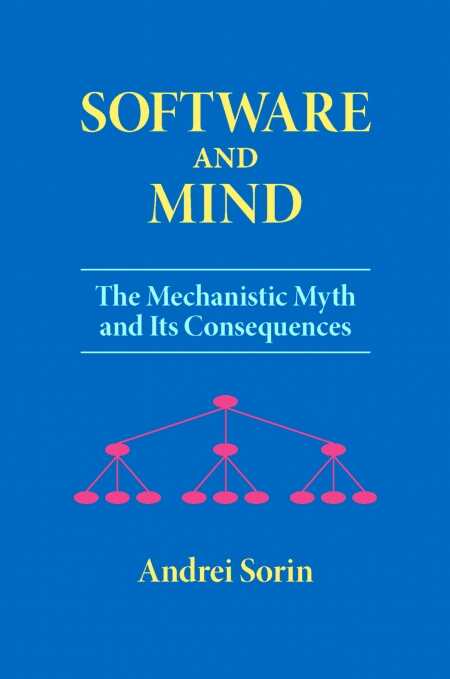Software and Mind
The Mechanistic Myth and Its Consequences
- 2013 INDIES Winner
- Honorable Mention, Science (Adult Nonfiction)
The scientific method of mechanism, by which the study of all things is broken down to their smallest building blocks and reassembled in hierarchical order, is the intellectual crowbar that tore down the religion-based myths that dominated thought before the Renaissance. Veteran programmer and computer scientist Andrei Sorin argues that mechanism has outlived its usefulness. Worse, it has become the new mythology, one as vigorously defended by today’s academic and technological elite as the papacy and the Inquisition protected the belief system of the Middle Ages.
As the jacket attests, Sorin has the credentials that demand respect when he talks about his field of expertise and the world in which he works. While his weighty, 944-page tome, Software and Mind, is at first look overwhelming and intimidating, the arguments and observations put forth in the massive work are surprisingly, and thankfully, understandable and approachable. There is a great deal of repetition, which the author freely admits is intentional, but that repetition is necessary if a reader without his background is to comprehend his thesis.
That thesis is a damning one. It accuses academic and “software elites” (many of whom he names) of imposing an Orwellian totalitarianism on not only the scientific computer software community, but also upon those who use its products. Sorin, like the great thinkers of the Renaissance and the Age of Enlightenment, seeks to break free of these artificial restraints, which he believes “attempt to reduce real-world problems to neat hierarchical structures of data, operations and features.”
Software and Mind is not a light or easy read, although Sorin works diligently to present his theories in a logical progression and in a language and style that does not require a reader to have an advanced degree to follow, understand, or digest. Engineers are often derided for their inability to communicate ideas in ways the layman can grasp. If that is a rule, Sorin is the exception.
Each of eight chapters is broken into sections, subsections, and what he calls “numbered parts.” Seven are self-contained journeys of exploration into such topics as “Language and Software,” “Pseudoscience,” and “From Mechanism to Totalitarianism.” One, however, is a book unto itself.
At more than 320 pages, Chapter Seven represents not only a physical third of the book, but also its theoretical core. Each of its three main sections are further subdivided into nine or ten subsections, and it is here that Sorin takes on what he sees as the true nemesis of freedom-loving software scientists everywhere: structured programming, object-oriented programming, and the relational database model. He derides these theories, once hailed as revolutionary, as not only “pseudoscience” but also as the equivalent of “totalitarianism.”
Sorin’s indictment of his profession is sure to stir up controversy and may come as a big surprise to many of his colleagues, let alone to the general public, which has come to revere software creators as something akin to the gods of old. Then again, false gods have fallen before, and Sorin, if he is indeed correct, may just be the scientist who cracks the mythological foundation upon which he claims the modern deities of the computer age stand.
Reviewed by
Mark McLaughlin
Disclosure: This article is not an endorsement, but a review. The publisher of this book provided free copies of the book and paid a small fee to have their book reviewed by a professional reviewer. Foreword Reviews and Clarion Reviews make no guarantee that the publisher will receive a positive review. Foreword Magazine, Inc. is disclosing this in accordance with the Federal Trade Commission’s 16 CFR, Part 255.

